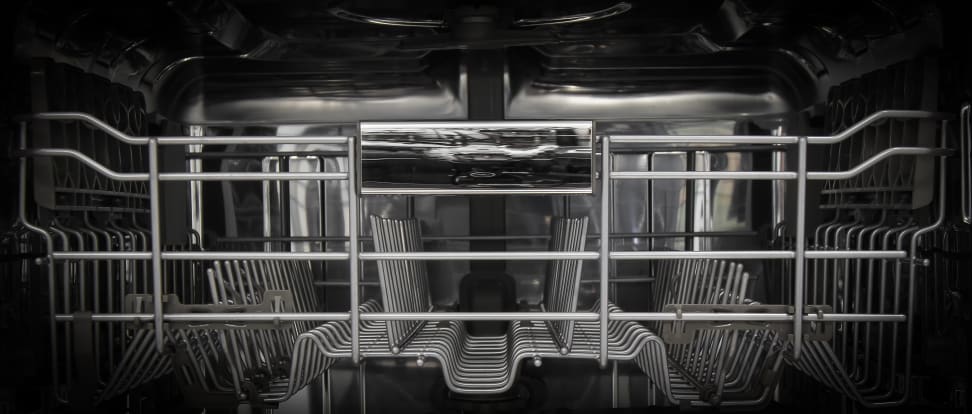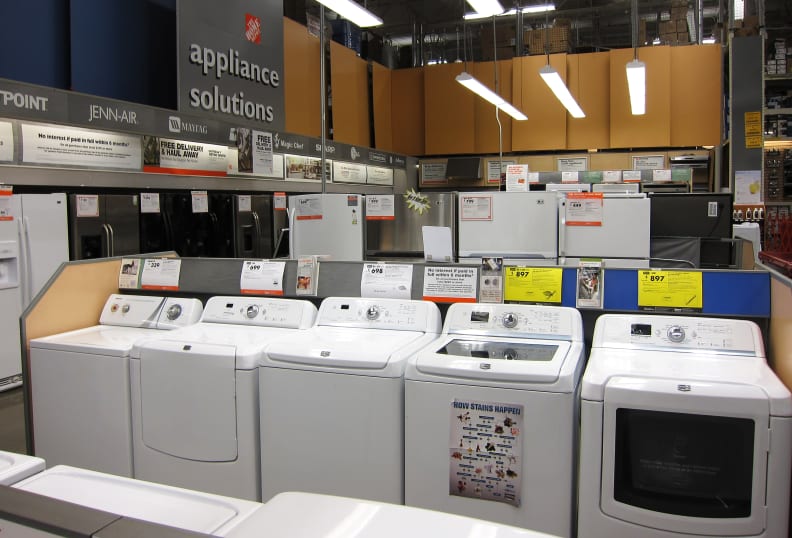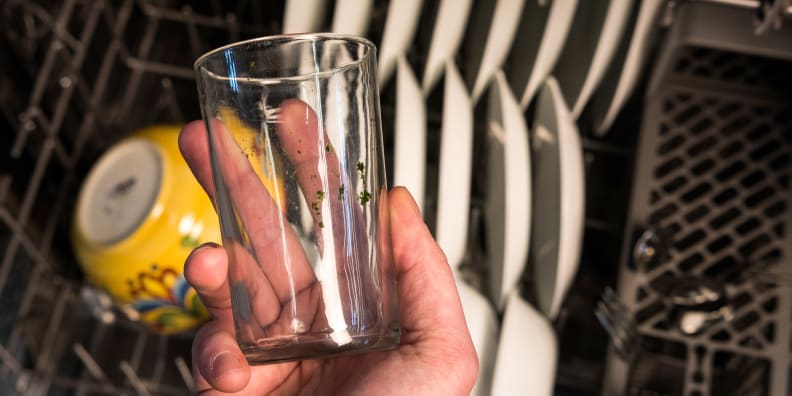Dishwasher Buying Guide
Everything you need to know to find the perfect dishwasher for you.
 Credit:
Reviewed.com / Johnny Yu
Credit:
Reviewed.com / Johnny Yu
Recommendations are independently chosen by Reviewed's editors. Purchases made through the links below may earn us and our publishing partners a commission. Prices were accurate at the time this article was published but may change over time.
Measure Twice, Buy Once Before you start shopping, make sure you know what size machine you're looking for.
What Matters to You? Price, performance, design—everyone's equation is unique. Decide what you care about in a dishwasher to find the right one for you.
How to Buy Tips and tricks for getting the best deal on the dishwasher you want.
Types of Dishwashers There are dishwashers for all living spaces.
Care, Cleaning, and Service How to keep your machine running like new.
1. Measure Twice, Buy Once
A dishwasher is a major purchase, and as with any major purchase, there are a lot of things to consider. These considerations range from the economical (price, size, efficiency) to the functional (drying temperature, capacity, cycle duration, noise level). However, there are some things that are simply out of your control.

Unless you want to buy a custom-front, counter-depth dishwasher like this Bosch, you're probably looking for a standard 24-inch machine.
Unless you’re in the market for a countertop or portable dishwasher, your options are limited to standard 24-inch or compact 18-inch models. Measure the width of your space before buying. And if you want one that’s going to sit perfectly flush with your cabinets—like in a home design magazine—you'll also need to grab a tape measure and determine your available depth.
Once you’ve got that squared away, it’s time to focus on three key considerations: value, performance, and design.
2. What Matters to You?
PRICE For some, price is the number-one concern; for others, it’s not even a factor. Before you go any further, decide where you fall on that spectrum and figure out how much you want to spend. Make sure your price range isn’t so narrow that it unduly limits your options with regard to dish capacity or efficiency. But be aware that, regardless of your budget, you can expect to spend at least $600 for a good dishwasher.
Read more: The Best Affordable Dishwashers of 2018
Water and energy consumption can impact the cost of your dishwasher over its lifetime, but virtually all modern machines tend to be in the same ballpark. Unless your local water and energy prices are exceptionally high, the difference from one unit to another will typically amount to just a few dollars per year. Extremely cheap dishwashers—those at or under the $300 price point—usually lack sensors and internal water heaters, and should generally be avoided.
PERFORMANCE If cost isn’t your biggest concern, performance probably is. Aside from sheer cleaning power, you also need to consider things like speed, drying cycle, and quietness (or lack thereof). A lot of dishwashers also come equipped with extra features like Delicates and Eco Wash cycles that may be important to you.
Read more: The Best Dishwashers of 2018
Some of these perks are less vital than others, and their importance depends largely on the types of dishes you’ll be putting in your machine. Don’t let frivolous extras tempt you into spending too much, but at the same time, don’t let a tight budget discourage you from legitimately useful features like sanitation cycles, bottle washing jets, and third racks.
DESIGN Finally, there’s design. Some buyers place serious value on the look of their dishwasher, particularly on how well it meshes with the rest of their kitchen. Fortunately, above a certain price point, most dishwashers can blend in with pretty much any modern kitchen design.
Read more: The Best Stainless Steel Dishwashers of 2018
Stainless steel is a near-universal option, though many manufacturers charge extra. Some finishes, like GE’s Slate and LG’s Black Diamond, would need to be purchased as a whole-kitchen suite to ensure a uniform look.
Read more: Should you upgrade your kitchen to black stainless steel?
You should also consider the control layout. Traditional designs feature buttons on the front of the machine, but many newer models move the controls to the top of the door to provide a cleaner, more modern aesthetic. To let you know when the dishes are clean, some of these machines will even project an indicator light or countdown timer onto the floor beneath the unit.
If you want your dishwasher to really blend in with your cabinetry, you may want to consider a panel-ready machine. These specialized models can accept custom fronts, but may require more intensive consultation with kitchen designers and installers.
3. How to Buy
There are two ways to shop for appliances in the 21st century: online, or in a brick-and-mortar store. Each option has its pros and cons, but if you’re serious about getting the right washer, you’ll probably want to try both.
You can use our Best Right Now roundup guides to find a dishwasher fit your needs.

Figure out which dishwashers you're interested in before you head to your local big box store.
As you conduct your research, note the MSRP of each model and check to see if any sellers currently have it on sale. But keep in mind that the retail price isn’t the full sum—there’s also the cost of delivery and installation. Depending on where you live, you may also have to pay sales tax, a cost that may or may not be applicable to online purchases.
Don’t skimp on installation. If you’re able to install a dishwasher yourself, that’s great! But keep in mind that there is some minor plumbing and electrical work involved, as well as some extra pieces that don't always come with your dishwasher. So, do your research ahead of time, and don't be afraid to pay your retailer (or third party handyman) to do the installation for you. Too many buyers overlook this crucial step and end up paying more than necessary.
Many retailers will also take care of "haul-away," taking your old dishwasher off your hands and disposing of it properly. If you opt out of those services—or the retailer doesn't offer them—contact your local municipality for information on how to dispose of old appliances.
4. Types of Dishwashers
INSTALL This is the most common type of dishwasher. It’s the familiar 24-inch-wide (or 18-inch-wide) machine that’s hooked up to the water intake in your kitchen. Unless you have a specific need for something compact or portable, this is what you’ll be buying.
PORTABLE These machines are roughly the same size as install dishwashers, but come with wheels. For smaller or modular kitchens, a portable dishwasher may be the best solution. Be aware, however, that these machines get their water from—and drain it back into—your sink, so you can’t use the tap while the dishwasher is running.
Read more: The Best Portable Dishwashers of 2018
COUNTERTOP Also referred to as “compact dishwashers,” these machines are ideal for really cramped living spaces. They have limited capacity—roughly half that of a traditional dishwasher—but they're more convenient and more efficient than hand-washing.
Read more: The Best Countertop Dishwashers of 2018
5. Care, Cleaning, and Service
Proper dishwasher care begins and ends with you.
Yes, there’s a certain degree of variation between brands and models, but much of a machine’s cleaning performance depends on how well you care for it. For example, most homeowners completely overlook the importance of cleaning out the dishwasher filter. This should ideally be done at least every other cycle, since food buildup in the filter can drastically reduce the machine’s cleaning power and lead to unsightly redeposit.

Redeposit is unsightly and unsanitary. Usually, it's the result of a poorly maintained dishwasher filter.
There’s one more enemy of good dishwasher performance: mold. Though it's unusual for it to become a serious problem, the fact is that dishwashers are dark, warm, moist environments that easily collect and redistribute food particles. There’s no better recipe for mold.
If mold shows up in your machine, periodically clean the interior with a bleach solution, wiping down any surface with mold or caked-on food debris. Do the same for the gaskets that run along the door. Remove the racks and check the spray jets for any additional debris. Once you’ve given the machine a thorough hand-washing, return the racks to their holders and run the empty dishwasher on a normal cleaning cycle.



